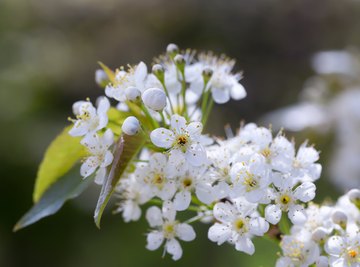
Pin cherries grow wild in forests across the northern United States and southern Canada. These plants produce a fruit that is a little too sour for eating fresh but is perfect for making jelly. Pin cherries are also known as Bird Cherries, Fire Cherries or Prunus pennsylvanica.
Other small, woodland trees produce red berries. Some, like chokecherries, are edible. Others, such as buckthorn, are not. Always make sure you are absolutely certain of your identification before eating any wild foods. Consult at least two reputable field guides or a trained expert, and when in doubt, do not eat the fruit.
Take a look at where the plant is growing. Pin cherry trees need a lot of sun and are often found in young, successional forests that are open and sunny. They are often one of the first species to move in after a disturbance such as fire or logging. Pin cherries grow in a variety of soil types.
Look at the structure of the tree. Pin cherry trees grow to about 30 feet tall. The trunk is narrow and straight. The tree has a flat, rounded crown.
Examine the bark. Pin cherry bark is smooth and shiny. The bark is reddish brown with orange lenticels, or horizontal stripes.
Look at the leaves. Pin cherry leaves are oblong or lance-shaped and are finely toothed along the edge. In the autumn, the leaves turn a bright red-orange color.
In the spring, look for flowers. Pin cherry flowers are small, white and have five petals. They grow in clumps of five to seven flowers.
Watch for the fruit in late summer or early fall. Pin cherries are bright red and about 1/4-inch wide. The fruit appears on long stems, in clusters all originating from the same point, like tines on an umbrella. The fruit is sour and contains a large stone inside. Many birds enjoy the fruit. During fall migration it may be hard to find a tree with very many ripe cherries left on it.
Warnings
Warnings
- Other small, woodland trees produce red berries. Some, like chokecherries, are edible. Others, such as buckthorn, are not. Always make sure you are absolutely certain of your identification before eating any wild foods. Consult at least two reputable field guides or a trained expert, and when in doubt, do not eat the fruit.
About the Author
Heidi Almond worked in the natural foods industry for more than seven years before becoming a full-time freelancer in 2010. She has been published in "Mother Earth News," "Legacy" magazine and in several local publications in Duluth, Minn. In 2002 Almond graduated cum laude from an environmental liberal arts college with a concentration in writing.
